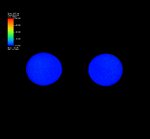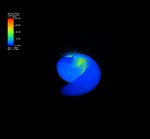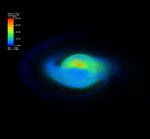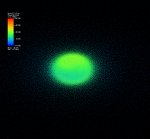|
Fig. 1:
Four snapshots of the collision of two initially cold neutron stars in
a binary. The computer simulated evolution covers only 0.02 seconds,
in which the two stars approach each other quickly due to
gravitational-wave emission (top left), collide (top right), merge
(bottom left), and form a dense, super heavy neutron star surrounded
by an extended, more dilute halo of hot gas (bottom right).
(Simulation: Andreas Bauswein und H.-Thomas Janka/MPA;
Visualisation: Markus Rampp/RZG)
|
|  |
”Gravitational waves belong to gravity just as light waves
belong to electromagnetism,“ says Prof. Dr. Bernd Brügmann from
the Friedrich-Schiller-University Jena, the spokesperson of the
research network. Where traditional astronomy with electromagnetic
waves reaches its limits, gravitational wave astronomy could carry on,
explains the professor for gravitational theory. ”Gravitational
waves contain information about black holes, the core of supernova
explosions, and even the Big Bang, the birth of our Universe.“
It is extremely difficult, however, to actually measure these waves.
Albert Einstein predicted gravitational waves in his General Theory of
Relativity in 1916, but to date they have been detected only
indirectly in objects that lose energy due to the emission of
gravitational waves. One of the main problems for a direct measurement
is the very low intensity of the signal. Innovations at existing
detectors over the coming years, however, should make the detection
possible.
For accurate predictions of the gravitational wave signal from
different astronomical objects, researchers at the Max Planck
Institute for Astrophysics develop models of the (asymmetric) core
collapse of massive stars at the end of their lifetimes or the merger
of two compact stars. These kinds of events are among the most
promising sources of gravitational waves. To accurately predict the
characteristics of such a signal, many different physical processes
have to be taken into account, such as relativistic flows, radiation
transport and microphysics. The latest available computational tools
for the individual processes have to be combined or new codes have to
be developed.
The German Research Foundation DFG has now approved about eight
million Euros additional funding for the SFB/TR7 Gravitational Wave
Astronomy. ”With this, the research network which started in
2003 can now continue its successful work up to 2014 and, among other
things, finance 30 science staff,“ says Prof. Brügmann. Some 80
physicists, astronomers and mathematicians participate in the SFB/TR7
in 17 projects. In the coming four years, these researchers from the
Friedrich-Schiller-University Jena, the Eberhard Karls University
Tübingen, the Leibniz University Hannover and the Max Planck
Institutes for Gravitational Physics in Hanover und Potsdam and for
Astrophysics in Garching will continue to hunt for gravitational
waves.
More information about the the SFB/TR7 Gravitational Wave Astronomy
 wwwsfb.tpi.uni-jena.de wwwsfb.tpi.uni-jena.de
 www.einsteinwelle.de www.einsteinwelle.de
Contact:
Prof. Dr. Bernd Brügmann
Theoretisch-Physikalisches Institut der Universität Jena
Fröbelstieg 1, 07743 Jena
Tel.: 03641 / 947111 or 947100
E-Mail: Bernd.Bruegmann uni-jena.de uni-jena.de
Local Contact:
PD Dr. Ewald Müller
Max-Planck-Institut für Astrophysik
Tel: +49 89 30000-2209
E-mail: emueller mpa-garching.mpg.de mpa-garching.mpg.de
Dr. Hannelore Hämmerle
Press Officer
Max-Planck-Institut für Astrophysik
und Max-Planck-Institut für extraterrestrische Physik
Tel: +49 89 30000-3980
E-Mail: hhaemmerle mpa-garching.mpg.de mpa-garching.mpg.de
|




 uni-jena.de
uni-jena.de